Project Management Methodologies: PRINCE2 vs. PMBOK Analysis
VerifiedAdded on 2021/04/17
|8
|1508
|55
Report
AI Summary
This report provides a comprehensive overview of project management methodologies, focusing on PRINCE2 and PMBOK. It explores the role of project methodology in successful project execution, emphasizing the importance of flexibility and adaptability. The report details the advantages of PRINCE2, including its adaptability and clearly defined roles, while also outlining the PMBOK guide and its ten components. It highlights the key differences between PRINCE2 and PMBOK, such as their origins and maintenance, as well as their similarities in project execution pipelines and risk management. The report further examines the relationship between PRINCE2 and the project life cycle, illustrating how the methodology aligns with various stages of a project. Overall, the report underscores the high acceptance of PRINCE2 due to its adaptability and stakeholder involvement, offering valuable insights into effective project management practices.
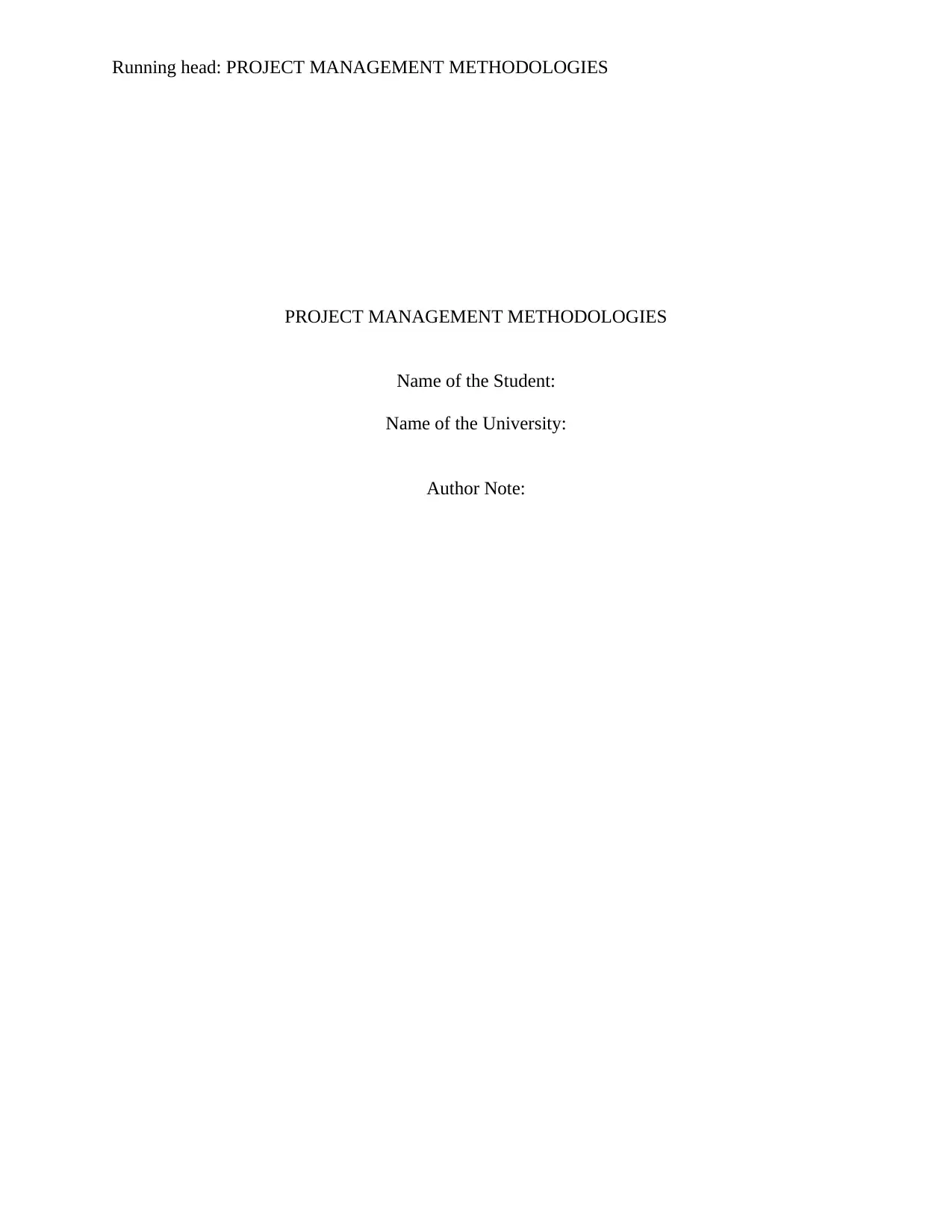
Running head: PROJECT MANAGEMENT METHODOLOGIES
PROJECT MANAGEMENT METHODOLOGIES
Name of the Student:
Name of the University:
Author Note:
PROJECT MANAGEMENT METHODOLOGIES
Name of the Student:
Name of the University:
Author Note:
Paraphrase This Document
Need a fresh take? Get an instant paraphrase of this document with our AI Paraphraser
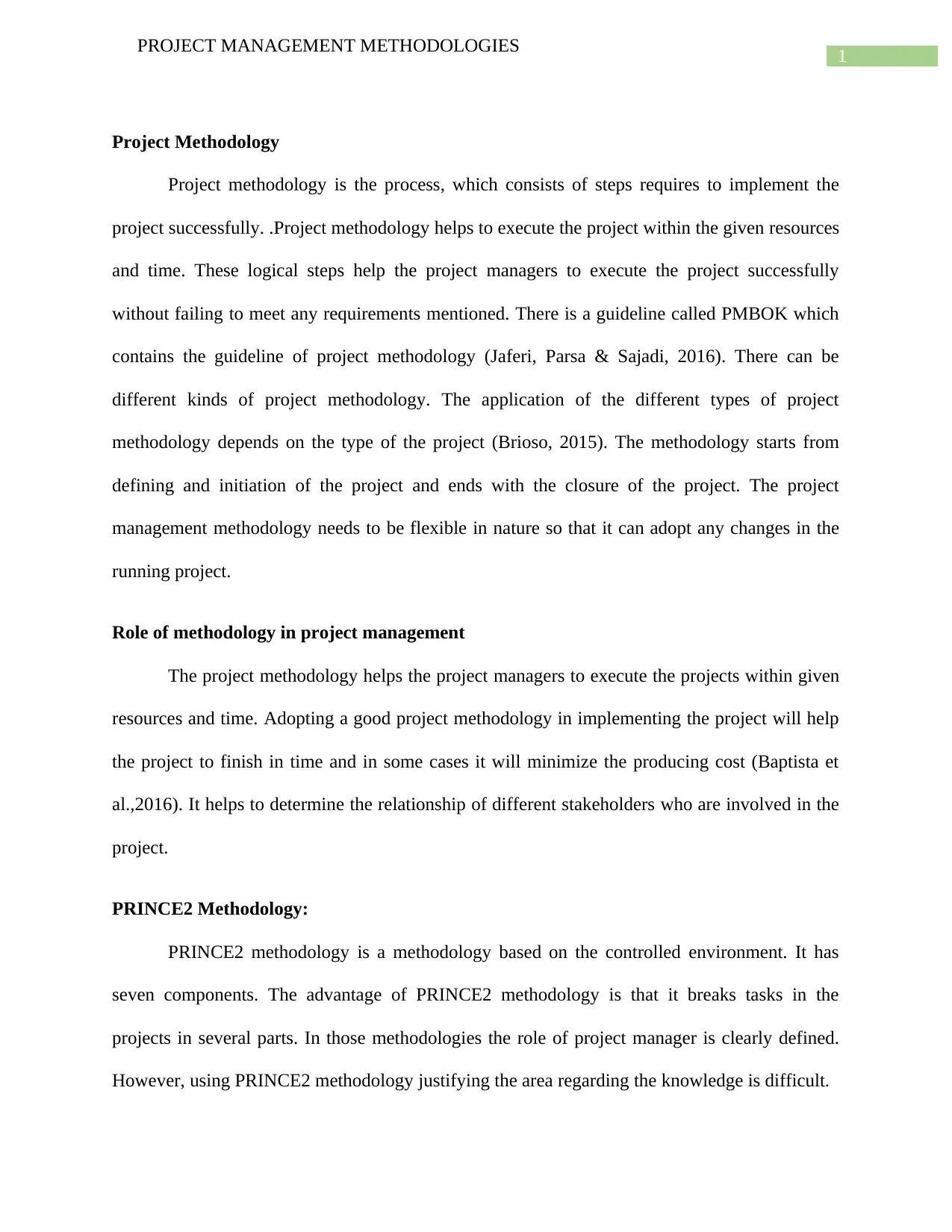
1
PROJECT MANAGEMENT METHODOLOGIES
Project Methodology
Project methodology is the process, which consists of steps requires to implement the
project successfully. .Project methodology helps to execute the project within the given resources
and time. These logical steps help the project managers to execute the project successfully
without failing to meet any requirements mentioned. There is a guideline called PMBOK which
contains the guideline of project methodology (Jaferi, Parsa & Sajadi, 2016). There can be
different kinds of project methodology. The application of the different types of project
methodology depends on the type of the project (Brioso, 2015). The methodology starts from
defining and initiation of the project and ends with the closure of the project. The project
management methodology needs to be flexible in nature so that it can adopt any changes in the
running project.
Role of methodology in project management
The project methodology helps the project managers to execute the projects within given
resources and time. Adopting a good project methodology in implementing the project will help
the project to finish in time and in some cases it will minimize the producing cost (Baptista et
al.,2016). It helps to determine the relationship of different stakeholders who are involved in the
project.
PRINCE2 Methodology:
PRINCE2 methodology is a methodology based on the controlled environment. It has
seven components. The advantage of PRINCE2 methodology is that it breaks tasks in the
projects in several parts. In those methodologies the role of project manager is clearly defined.
However, using PRINCE2 methodology justifying the area regarding the knowledge is difficult.
PROJECT MANAGEMENT METHODOLOGIES
Project Methodology
Project methodology is the process, which consists of steps requires to implement the
project successfully. .Project methodology helps to execute the project within the given resources
and time. These logical steps help the project managers to execute the project successfully
without failing to meet any requirements mentioned. There is a guideline called PMBOK which
contains the guideline of project methodology (Jaferi, Parsa & Sajadi, 2016). There can be
different kinds of project methodology. The application of the different types of project
methodology depends on the type of the project (Brioso, 2015). The methodology starts from
defining and initiation of the project and ends with the closure of the project. The project
management methodology needs to be flexible in nature so that it can adopt any changes in the
running project.
Role of methodology in project management
The project methodology helps the project managers to execute the projects within given
resources and time. Adopting a good project methodology in implementing the project will help
the project to finish in time and in some cases it will minimize the producing cost (Baptista et
al.,2016). It helps to determine the relationship of different stakeholders who are involved in the
project.
PRINCE2 Methodology:
PRINCE2 methodology is a methodology based on the controlled environment. It has
seven components. The advantage of PRINCE2 methodology is that it breaks tasks in the
projects in several parts. In those methodologies the role of project manager is clearly defined.
However, using PRINCE2 methodology justifying the area regarding the knowledge is difficult.
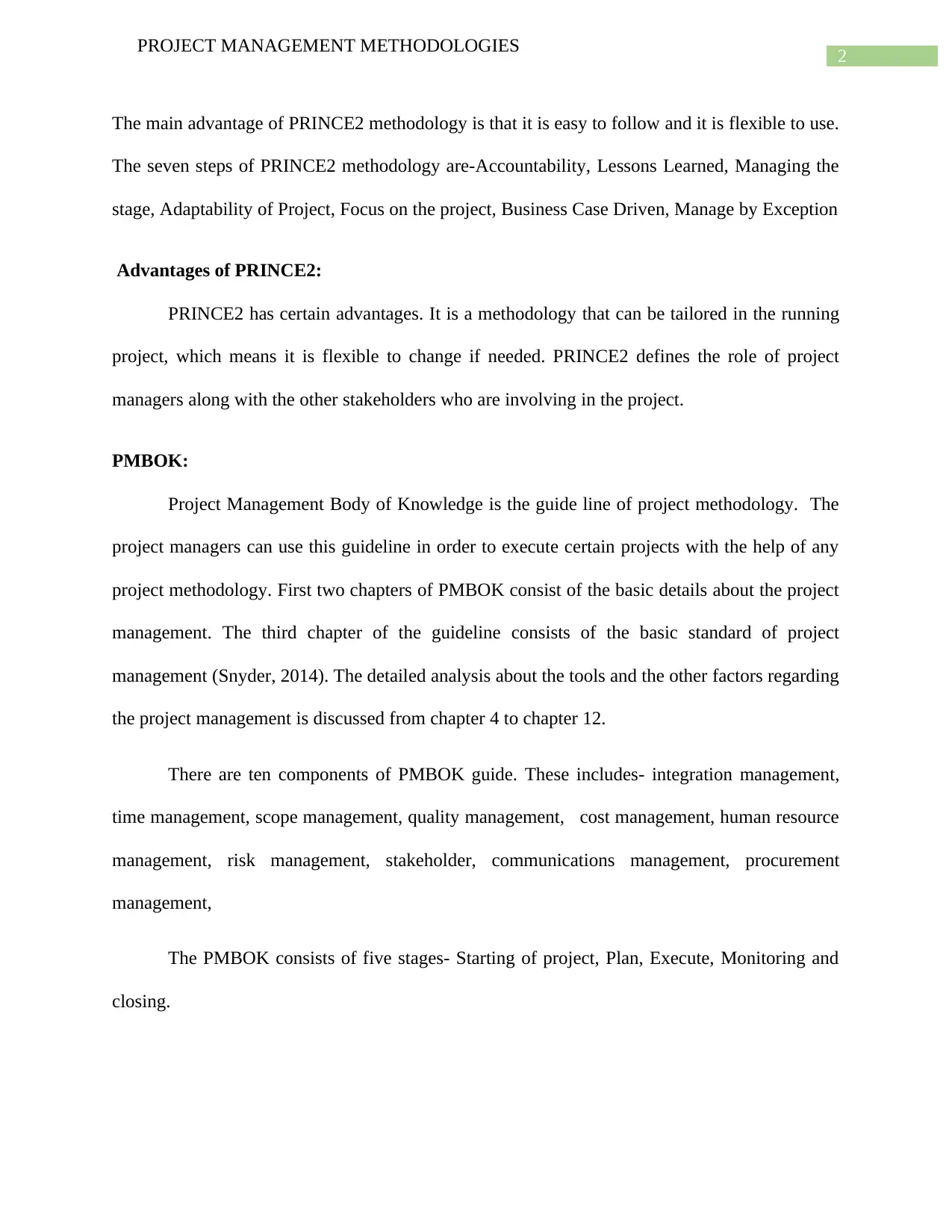
2
PROJECT MANAGEMENT METHODOLOGIES
The main advantage of PRINCE2 methodology is that it is easy to follow and it is flexible to use.
The seven steps of PRINCE2 methodology are-Accountability, Lessons Learned, Managing the
stage, Adaptability of Project, Focus on the project, Business Case Driven, Manage by Exception
Advantages of PRINCE2:
PRINCE2 has certain advantages. It is a methodology that can be tailored in the running
project, which means it is flexible to change if needed. PRINCE2 defines the role of project
managers along with the other stakeholders who are involving in the project.
PMBOK:
Project Management Body of Knowledge is the guide line of project methodology. The
project managers can use this guideline in order to execute certain projects with the help of any
project methodology. First two chapters of PMBOK consist of the basic details about the project
management. The third chapter of the guideline consists of the basic standard of project
management (Snyder, 2014). The detailed analysis about the tools and the other factors regarding
the project management is discussed from chapter 4 to chapter 12.
There are ten components of PMBOK guide. These includes- integration management,
time management, scope management, quality management, cost management, human resource
management, risk management, stakeholder, communications management, procurement
management,
The PMBOK consists of five stages- Starting of project, Plan, Execute, Monitoring and
closing.
PROJECT MANAGEMENT METHODOLOGIES
The main advantage of PRINCE2 methodology is that it is easy to follow and it is flexible to use.
The seven steps of PRINCE2 methodology are-Accountability, Lessons Learned, Managing the
stage, Adaptability of Project, Focus on the project, Business Case Driven, Manage by Exception
Advantages of PRINCE2:
PRINCE2 has certain advantages. It is a methodology that can be tailored in the running
project, which means it is flexible to change if needed. PRINCE2 defines the role of project
managers along with the other stakeholders who are involving in the project.
PMBOK:
Project Management Body of Knowledge is the guide line of project methodology. The
project managers can use this guideline in order to execute certain projects with the help of any
project methodology. First two chapters of PMBOK consist of the basic details about the project
management. The third chapter of the guideline consists of the basic standard of project
management (Snyder, 2014). The detailed analysis about the tools and the other factors regarding
the project management is discussed from chapter 4 to chapter 12.
There are ten components of PMBOK guide. These includes- integration management,
time management, scope management, quality management, cost management, human resource
management, risk management, stakeholder, communications management, procurement
management,
The PMBOK consists of five stages- Starting of project, Plan, Execute, Monitoring and
closing.
⊘ This is a preview!⊘
Do you want full access?
Subscribe today to unlock all pages.

Trusted by 1+ million students worldwide
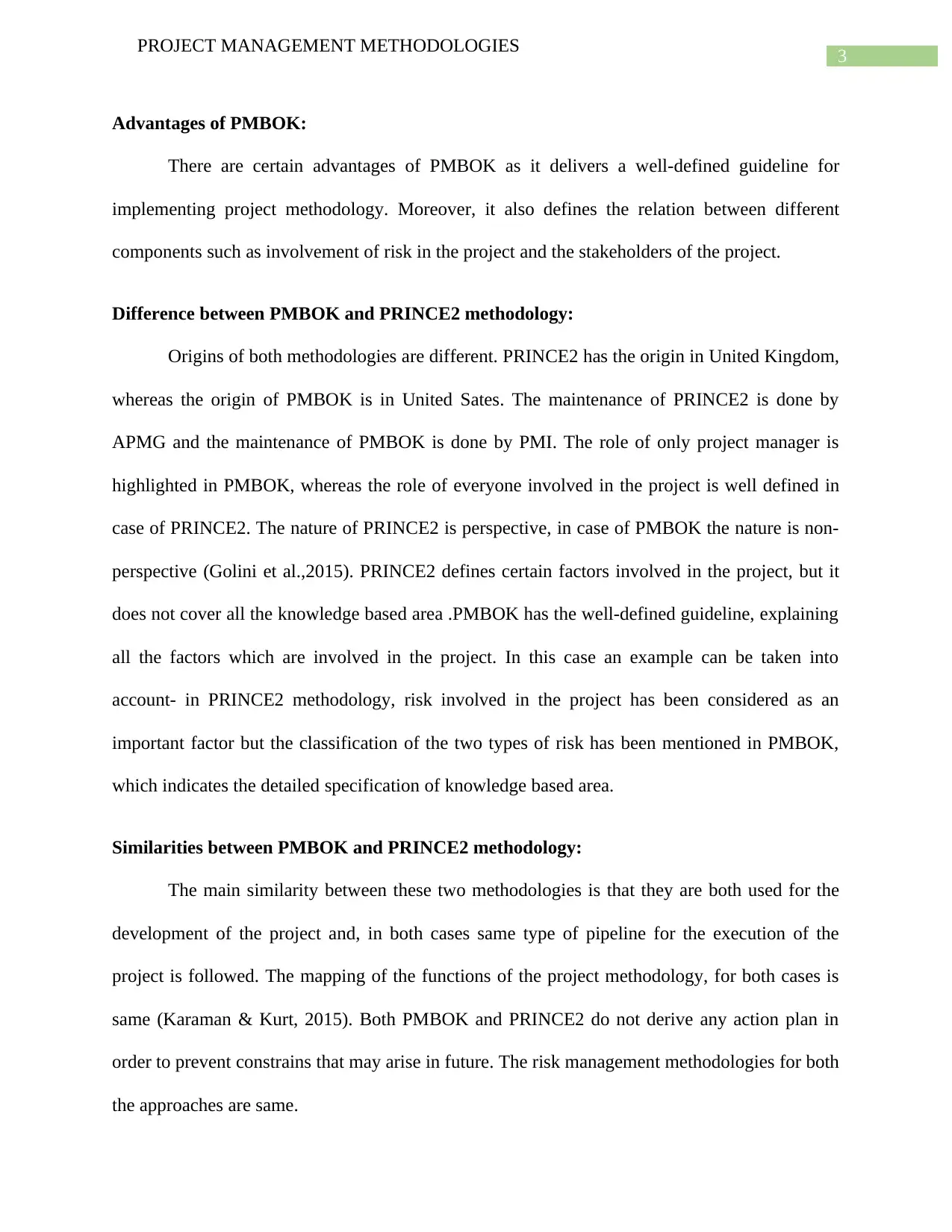
3
PROJECT MANAGEMENT METHODOLOGIES
Advantages of PMBOK:
There are certain advantages of PMBOK as it delivers a well-defined guideline for
implementing project methodology. Moreover, it also defines the relation between different
components such as involvement of risk in the project and the stakeholders of the project.
Difference between PMBOK and PRINCE2 methodology:
Origins of both methodologies are different. PRINCE2 has the origin in United Kingdom,
whereas the origin of PMBOK is in United Sates. The maintenance of PRINCE2 is done by
APMG and the maintenance of PMBOK is done by PMI. The role of only project manager is
highlighted in PMBOK, whereas the role of everyone involved in the project is well defined in
case of PRINCE2. The nature of PRINCE2 is perspective, in case of PMBOK the nature is non-
perspective (Golini et al.,2015). PRINCE2 defines certain factors involved in the project, but it
does not cover all the knowledge based area .PMBOK has the well-defined guideline, explaining
all the factors which are involved in the project. In this case an example can be taken into
account- in PRINCE2 methodology, risk involved in the project has been considered as an
important factor but the classification of the two types of risk has been mentioned in PMBOK,
which indicates the detailed specification of knowledge based area.
Similarities between PMBOK and PRINCE2 methodology:
The main similarity between these two methodologies is that they are both used for the
development of the project and, in both cases same type of pipeline for the execution of the
project is followed. The mapping of the functions of the project methodology, for both cases is
same (Karaman & Kurt, 2015). Both PMBOK and PRINCE2 do not derive any action plan in
order to prevent constrains that may arise in future. The risk management methodologies for both
the approaches are same.
PROJECT MANAGEMENT METHODOLOGIES
Advantages of PMBOK:
There are certain advantages of PMBOK as it delivers a well-defined guideline for
implementing project methodology. Moreover, it also defines the relation between different
components such as involvement of risk in the project and the stakeholders of the project.
Difference between PMBOK and PRINCE2 methodology:
Origins of both methodologies are different. PRINCE2 has the origin in United Kingdom,
whereas the origin of PMBOK is in United Sates. The maintenance of PRINCE2 is done by
APMG and the maintenance of PMBOK is done by PMI. The role of only project manager is
highlighted in PMBOK, whereas the role of everyone involved in the project is well defined in
case of PRINCE2. The nature of PRINCE2 is perspective, in case of PMBOK the nature is non-
perspective (Golini et al.,2015). PRINCE2 defines certain factors involved in the project, but it
does not cover all the knowledge based area .PMBOK has the well-defined guideline, explaining
all the factors which are involved in the project. In this case an example can be taken into
account- in PRINCE2 methodology, risk involved in the project has been considered as an
important factor but the classification of the two types of risk has been mentioned in PMBOK,
which indicates the detailed specification of knowledge based area.
Similarities between PMBOK and PRINCE2 methodology:
The main similarity between these two methodologies is that they are both used for the
development of the project and, in both cases same type of pipeline for the execution of the
project is followed. The mapping of the functions of the project methodology, for both cases is
same (Karaman & Kurt, 2015). Both PMBOK and PRINCE2 do not derive any action plan in
order to prevent constrains that may arise in future. The risk management methodologies for both
the approaches are same.
Paraphrase This Document
Need a fresh take? Get an instant paraphrase of this document with our AI Paraphraser
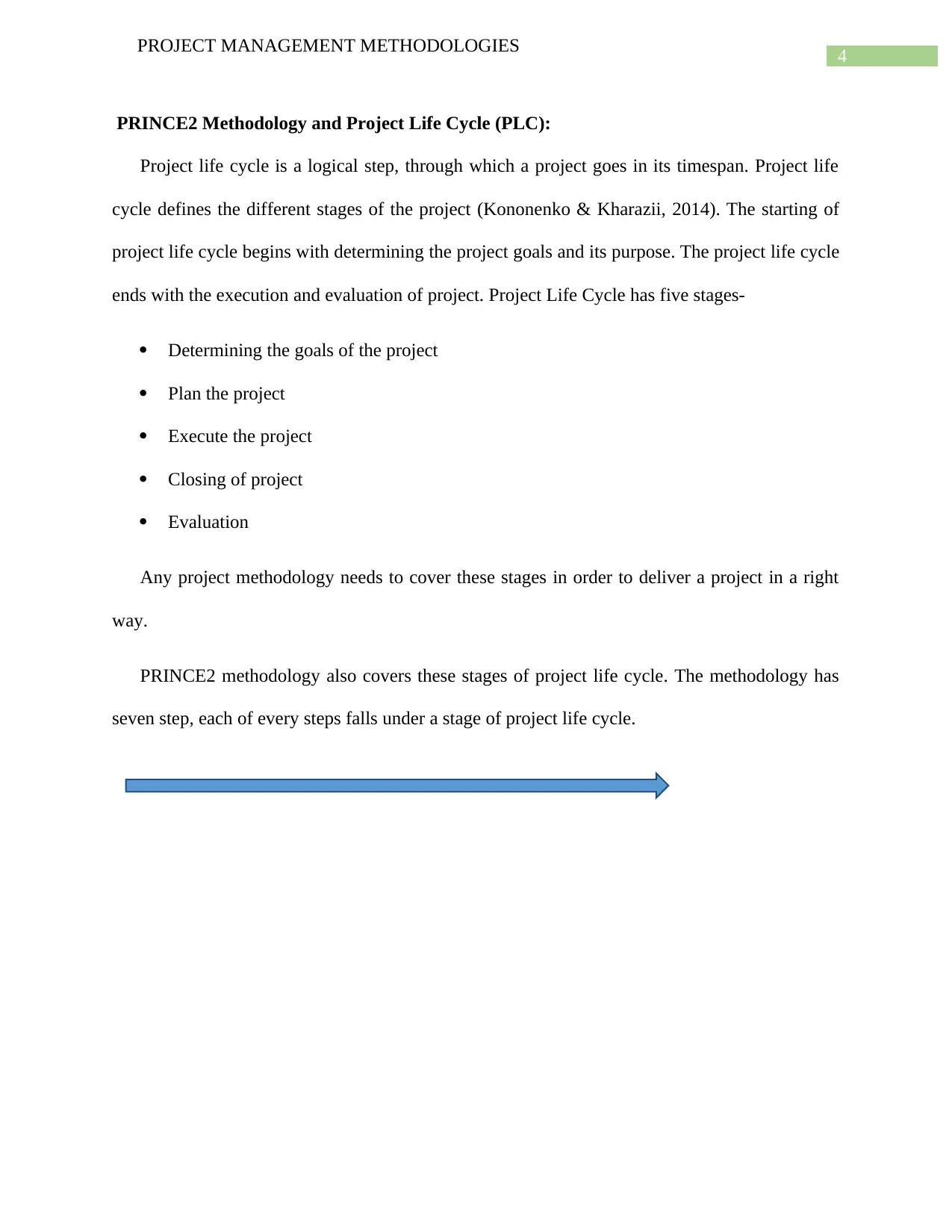
4
PROJECT MANAGEMENT METHODOLOGIES
PRINCE2 Methodology and Project Life Cycle (PLC):
Project life cycle is a logical step, through which a project goes in its timespan. Project life
cycle defines the different stages of the project (Kononenko & Kharazii, 2014). The starting of
project life cycle begins with determining the project goals and its purpose. The project life cycle
ends with the execution and evaluation of project. Project Life Cycle has five stages-
Determining the goals of the project
Plan the project
Execute the project
Closing of project
Evaluation
Any project methodology needs to cover these stages in order to deliver a project in a right
way.
PRINCE2 methodology also covers these stages of project life cycle. The methodology has
seven step, each of every steps falls under a stage of project life cycle.
PROJECT MANAGEMENT METHODOLOGIES
PRINCE2 Methodology and Project Life Cycle (PLC):
Project life cycle is a logical step, through which a project goes in its timespan. Project life
cycle defines the different stages of the project (Kononenko & Kharazii, 2014). The starting of
project life cycle begins with determining the project goals and its purpose. The project life cycle
ends with the execution and evaluation of project. Project Life Cycle has five stages-
Determining the goals of the project
Plan the project
Execute the project
Closing of project
Evaluation
Any project methodology needs to cover these stages in order to deliver a project in a right
way.
PRINCE2 methodology also covers these stages of project life cycle. The methodology has
seven step, each of every steps falls under a stage of project life cycle.
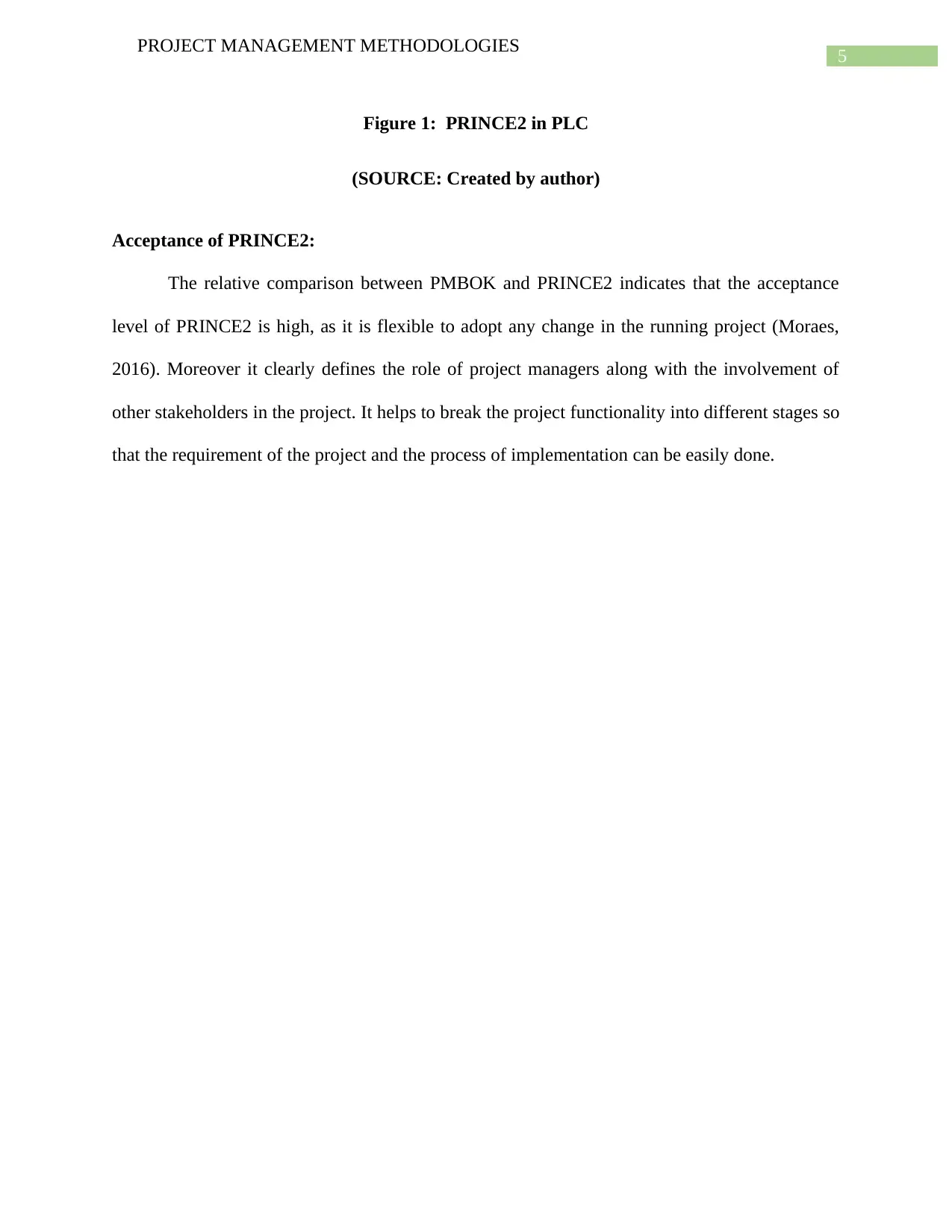
5
PROJECT MANAGEMENT METHODOLOGIES
Figure 1: PRINCE2 in PLC
(SOURCE: Created by author)
Acceptance of PRINCE2:
The relative comparison between PMBOK and PRINCE2 indicates that the acceptance
level of PRINCE2 is high, as it is flexible to adopt any change in the running project (Moraes,
2016). Moreover it clearly defines the role of project managers along with the involvement of
other stakeholders in the project. It helps to break the project functionality into different stages so
that the requirement of the project and the process of implementation can be easily done.
PROJECT MANAGEMENT METHODOLOGIES
Figure 1: PRINCE2 in PLC
(SOURCE: Created by author)
Acceptance of PRINCE2:
The relative comparison between PMBOK and PRINCE2 indicates that the acceptance
level of PRINCE2 is high, as it is flexible to adopt any change in the running project (Moraes,
2016). Moreover it clearly defines the role of project managers along with the involvement of
other stakeholders in the project. It helps to break the project functionality into different stages so
that the requirement of the project and the process of implementation can be easily done.
⊘ This is a preview!⊘
Do you want full access?
Subscribe today to unlock all pages.

Trusted by 1+ million students worldwide
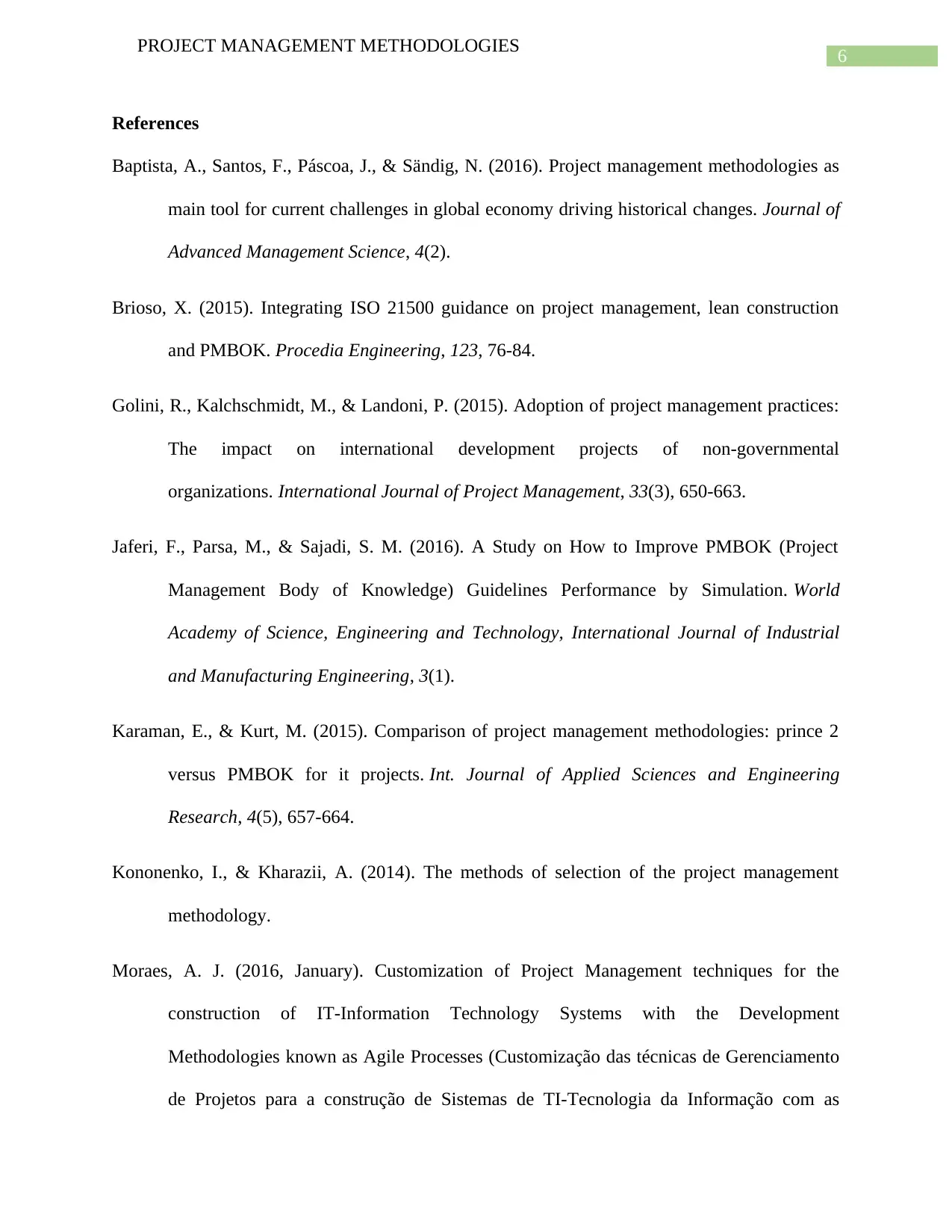
6
PROJECT MANAGEMENT METHODOLOGIES
References
Baptista, A., Santos, F., Páscoa, J., & Sändig, N. (2016). Project management methodologies as
main tool for current challenges in global economy driving historical changes. Journal of
Advanced Management Science, 4(2).
Brioso, X. (2015). Integrating ISO 21500 guidance on project management, lean construction
and PMBOK. Procedia Engineering, 123, 76-84.
Golini, R., Kalchschmidt, M., & Landoni, P. (2015). Adoption of project management practices:
The impact on international development projects of non-governmental
organizations. International Journal of Project Management, 33(3), 650-663.
Jaferi, F., Parsa, M., & Sajadi, S. M. (2016). A Study on How to Improve PMBOK (Project
Management Body of Knowledge) Guidelines Performance by Simulation. World
Academy of Science, Engineering and Technology, International Journal of Industrial
and Manufacturing Engineering, 3(1).
Karaman, E., & Kurt, M. (2015). Comparison of project management methodologies: prince 2
versus PMBOK for it projects. Int. Journal of Applied Sciences and Engineering
Research, 4(5), 657-664.
Kononenko, I., & Kharazii, A. (2014). The methods of selection of the project management
methodology.
Moraes, A. J. (2016, January). Customization of Project Management techniques for the
construction of IT-Information Technology Systems with the Development
Methodologies known as Agile Processes (Customização das técnicas de Gerenciamento
de Projetos para a construção de Sistemas de TI-Tecnologia da Informação com as
PROJECT MANAGEMENT METHODOLOGIES
References
Baptista, A., Santos, F., Páscoa, J., & Sändig, N. (2016). Project management methodologies as
main tool for current challenges in global economy driving historical changes. Journal of
Advanced Management Science, 4(2).
Brioso, X. (2015). Integrating ISO 21500 guidance on project management, lean construction
and PMBOK. Procedia Engineering, 123, 76-84.
Golini, R., Kalchschmidt, M., & Landoni, P. (2015). Adoption of project management practices:
The impact on international development projects of non-governmental
organizations. International Journal of Project Management, 33(3), 650-663.
Jaferi, F., Parsa, M., & Sajadi, S. M. (2016). A Study on How to Improve PMBOK (Project
Management Body of Knowledge) Guidelines Performance by Simulation. World
Academy of Science, Engineering and Technology, International Journal of Industrial
and Manufacturing Engineering, 3(1).
Karaman, E., & Kurt, M. (2015). Comparison of project management methodologies: prince 2
versus PMBOK for it projects. Int. Journal of Applied Sciences and Engineering
Research, 4(5), 657-664.
Kononenko, I., & Kharazii, A. (2014). The methods of selection of the project management
methodology.
Moraes, A. J. (2016, January). Customization of Project Management techniques for the
construction of IT-Information Technology Systems with the Development
Methodologies known as Agile Processes (Customização das técnicas de Gerenciamento
de Projetos para a construção de Sistemas de TI-Tecnologia da Informação com as
Paraphrase This Document
Need a fresh take? Get an instant paraphrase of this document with our AI Paraphraser
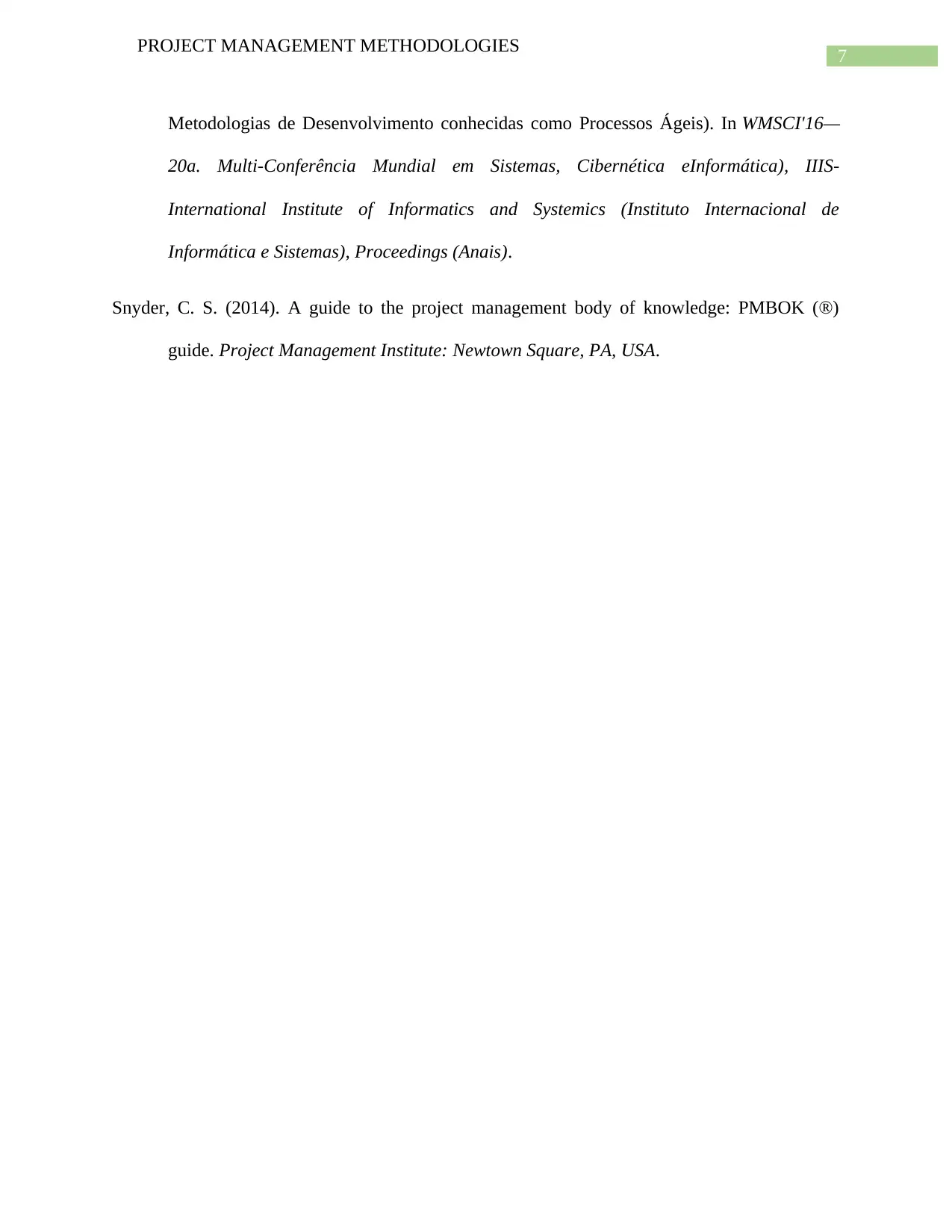
7
PROJECT MANAGEMENT METHODOLOGIES
Metodologias de Desenvolvimento conhecidas como Processos Ágeis). In WMSCI'16—
20a. Multi-Conferência Mundial em Sistemas, Cibernética eInformática), IIIS-
International Institute of Informatics and Systemics (Instituto Internacional de
Informática e Sistemas), Proceedings (Anais).
Snyder, C. S. (2014). A guide to the project management body of knowledge: PMBOK (®)
guide. Project Management Institute: Newtown Square, PA, USA.
PROJECT MANAGEMENT METHODOLOGIES
Metodologias de Desenvolvimento conhecidas como Processos Ágeis). In WMSCI'16—
20a. Multi-Conferência Mundial em Sistemas, Cibernética eInformática), IIIS-
International Institute of Informatics and Systemics (Instituto Internacional de
Informática e Sistemas), Proceedings (Anais).
Snyder, C. S. (2014). A guide to the project management body of knowledge: PMBOK (®)
guide. Project Management Institute: Newtown Square, PA, USA.
1 out of 8
Related Documents
Your All-in-One AI-Powered Toolkit for Academic Success.
+13062052269
info@desklib.com
Available 24*7 on WhatsApp / Email
![[object Object]](/_next/static/media/star-bottom.7253800d.svg)
Unlock your academic potential
Copyright © 2020–2025 A2Z Services. All Rights Reserved. Developed and managed by ZUCOL.




